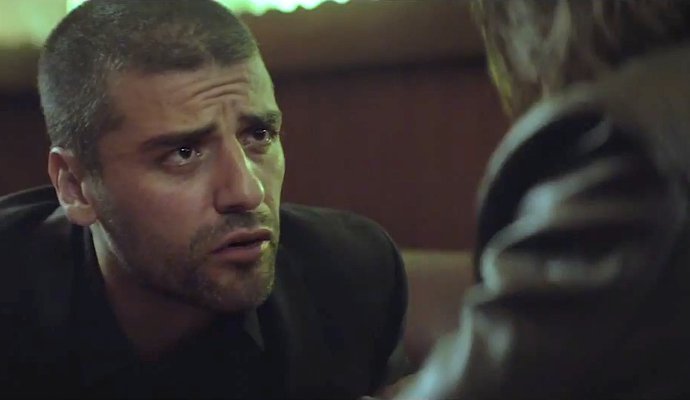Hungarian director Laszlo Nemes’ Holocaust film “Son of
Saul” hit me hard. After my screening I walked out of the auditorium feeling
emotionally depleted. On the bus ride back to my house I sat quietly in a daze.
At home it took me a few hours of watching “The Simpsons” to get back to my
normal self. I can’t think of the last time a movie affected me like that. I
can’t remember the last time a movie left me feeling physically nauseous. Nearly
three weeks later, the film is still ingrained in my mind. “Son of Saul” is an
overwhelming (in the best way possible), immersive and all around unforgettable
experience.
The picture doesn’t give you a chance to settle in and get
ready. I generally take notes while watching so I’m usually able to pull myself
away from a movie. During “Son of Saul” I couldn’t take my eyes off the screen.
After unsuccessfully trying to take notes I closed my notebook and set it
aside. Right from the start Nemes drops us right into the middle of the action,
practically mid sentence and keeps on moving. The characters all know one
another and have been occupying this cinematic space for quite some time.
Meanwhile the audience is disoriented; we don’t know where we are, or even when
we are. We’re outsiders dropped into this chaotic, terrifying environment.
Eventually we’re able
to decipher a visible narrative pattern. The film revolves Auschwitz prisoner
Saul Auslander (Geza Rohrig), a member of the Sonderkommando, a group of
prisoners who were forced to help with the disposal of gas chamber victims.
“Son of Saul” uses the traditional 1.33.1 aspect ratio and is shot only in
close ups. With the exception of a sequence near the end, the film is told from
the point of view of Auslander—we experience things only when he does. This
visual scheme creates a sensation of intense claustrophobia in the viewer; we
spend most of the movie trapped in cramped, windowless, dimly lit spaces of
death. The experience is suffocating and uncomfortable at times. We watch as
Auslander leads a group of nude, frightened, confused prisoners into a death
chamber. We watch as he is forced to clean the place up afterwards-- scrubbing
blood off the floor and stacking corpses. It’s during one of these “routine”
tasks that Auslander discovers the corpse of his son (or at least what he
believes to be his son) and he spends the rest of the movie trying to give him
a proper burial.
That’s pretty much it as far as plot’s concerned but we
don’t need anything else. The stripped down nature of the narrative is
refreshing. At this point, Holocaust films have become their own subgenre. By focusing
on a member of the Sonderkommando, “Son of Saul” finds its own unique entry
point into the subgenre. The Sonderkommando occupy a peculiar middle ground
between prisoner and oppressor; they’re forced to lead their own people to
death but at the same time their own execution is right around the corner. The
weight of Auslander’s seemingly simple quest is immense: he’s trying to retain
some semblance of his humanity in a place that’s devoid of it. You may find
yourself feeling frustrated by Auslander’s actions, you may wonder why he’s
going to such great lengths to bury his son but the film ultimately asks you to
empathize with him. Put yourself in his shoes and ask how you would respond if
you were in his situation, if you were in the thick of so much death? Rohrig is
phenomenal; giving a powerfully understated performance that relies on subtle
bodily gestures and reactions (most of the time, the camera stays firmly
planted on his anguished face) rather than extended monologues or “big” actor-y
moments.
We see a lot of graphic, unspeakable images that are
presented in a blunt, yet non-exploitive, non-showing way. There’s no
instrumental score to heighten the drama and emotion on screen. Nemes knows to
let these raw images speak for themselves. Because of the film’s highly
subjective perspective it doesn’t linger too long on individual moments of
suffering. It’s always on the move. Auslander has become so immune and
desensitized to this horrible reality that he doesn’t feel the need to stop and
take it in anymore. From a purely technical standpoint, “Son of Saul” is a
meticulously crafted piece of brilliance. The film is composed of lengthy,
activity filled single take sequences. The huge amount of rehearsal and
planning they must have done is staggering to think about. However, while
you’re watching you’re not thinking about its style—you’re letting this visceral,
emotionally resonant experience wash over and pull you along.
I recently listed “Son of Saul” as the fifth best movie of2015, which may have been a little generous. This is not a knock against the
film but movies I consider the “best” are ones that I love and can’t wait to watch
again. “Son of Saul” is a movie that I don’t look forward to watching again. But
any piece of art that can inspire such an intense physical reaction in me is
incredibly effective and one that shouldn’t be forgotten. We go to movies to be
entertained, sometimes to escape. But we also go to movies to feel
uncomfortable, to be pushed out of our comfort zones and see things that we may
not want to see. “Son of Saul” is one of those movies.
A-

